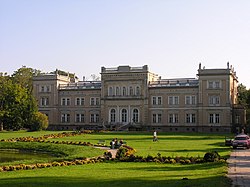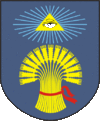Plungė
| Plungė | |||
|---|---|---|---|
| City | |||

Plungė Manor
|
|||
|
|||
| Location of Plungė | |||
| Coordinates: 55°55′N 21°51′E / 55.917°N 21.850°ECoordinates: 55°55′N 21°51′E / 55.917°N 21.850°E | |||
| Country |
|
||
| Ethnographic region | Samogitia | ||
| County | Telšiai County | ||
| Municipality | Plungė district municipality | ||
| Eldership | Plungė town eldership | ||
| Capital of |
Plungė district municipality Plungė town eldership Plungė rural eldership |
||
| First mentioned | 1567 | ||
| Granted city rights | 1792 | ||
| Population (2015) | |||
| • Total | 18,904 (16th) | ||
| Time zone | EET (UTC+2) | ||
| • Summer (DST) | EEST (UTC+3) | ||
| Website | http://www.plunge.lt | ||
Plungė (![]() pronunciation , Samogitian: Plongė, Yiddish: פּלונגיאַן) is a city in Lithuania with 23,246 inhabitants. It has a crab stick factory which exports to many countries in Europe.
pronunciation , Samogitian: Plongė, Yiddish: פּלונגיאַן) is a city in Lithuania with 23,246 inhabitants. It has a crab stick factory which exports to many countries in Europe.
Before World War II, Plungė had a large Jewish population (see The Holocaust in Lithuania).
It is thought that the territory in which Plungė is situated was inhabited in 5th–1st centuries BC. After the Treaty of Melno country seats were started establishing in the forests of Samogitia. From the 14th century to the middle of the 16th century, Plungė was a part of Gandinga volost as an ordinary settlement. Later, the population of Plungė started to grow faster and surpassed the population of Gandinga. In 1567 Plungė was mentioned as a town.
On January 13, 1792, Plungė granted Magdeburg rights. From 1806 to 1873 Plungė belonged to Platon Zubov, and later – to Oginskiai, who built a palace here in 1879.
During the interwar period there was established gymnasium in 1925 and built railway branch-line in 1932. In 1933 current Catholic Church was consecrated. Since the private hospital was founded in 1939, maternity, surgical sections started their activities. Jewish community composed about 44% of inhabitants whereas about 55% of inhabitants were Lithuanians. According to that Jewish were active participants governing the city. However, in events of 1941 almost all Jewish community was destroyed by the Nazis and their local Lithuanian collaborators in mass executions.
...
Wikipedia



